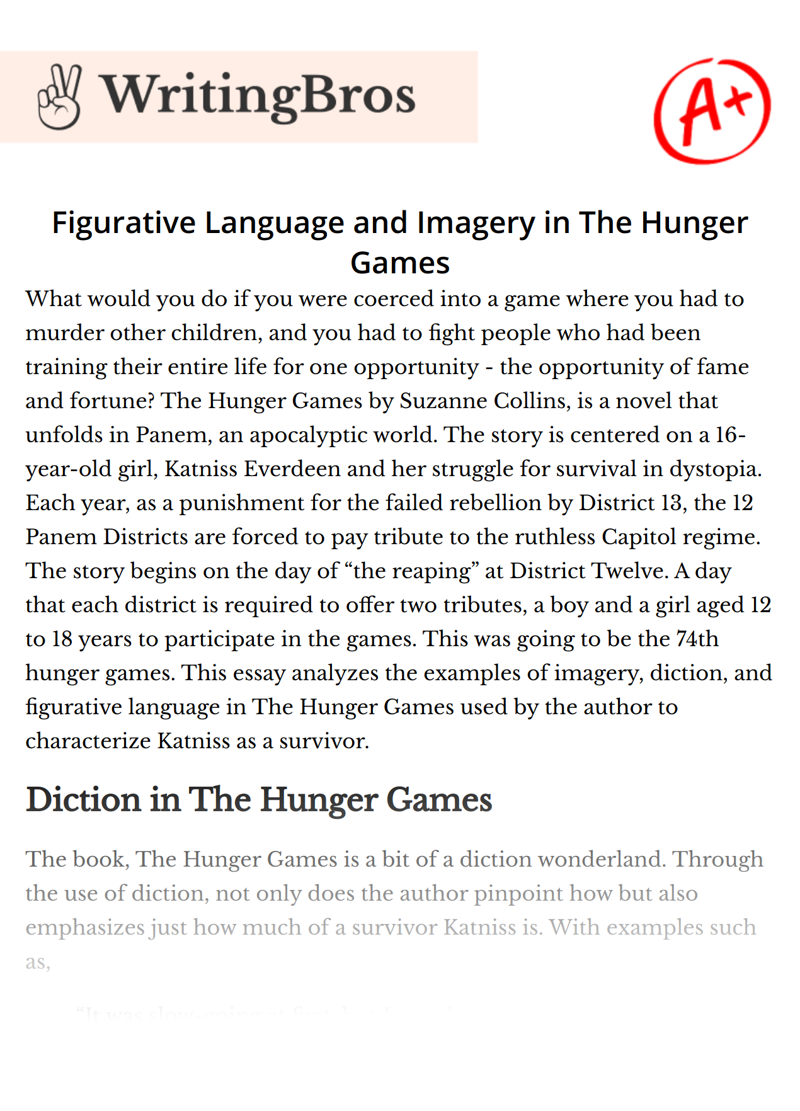Imagery In The Hunger Games: A Deep Dive Into Suzanne Collins' Dystopian World
The Hunger Games series by Suzanne Collins has captivated millions of readers worldwide, not just with its thrilling plot and complex characters, but also through its vivid use of imagery. The powerful imagery in The Hunger Games enhances the narrative, allowing readers to immerse themselves in the bleak yet fascinating world of Panem. This article explores the various layers of imagery in The Hunger Games, analyzing how they contribute to the overall themes and character development in the series.
Imagery is a vital component of literature that evokes sensory experiences, and Collins masterfully employs this technique throughout the trilogy. From the stark contrasts between the opulence of the Capitol and the poverty of the districts to the visceral descriptions of the Games themselves, Collins paints a vivid picture that engages readers’ senses and emotions. By delving into the key examples of imagery in The Hunger Games, we can better understand the implications of these descriptions and their significance to the story.
In this comprehensive analysis, we will examine eight specific aspects of imagery in The Hunger Games, providing insights into how these elements serve to enhance the narrative and resonate with the audience. Whether you are a longtime fan of the series or a newcomer, this exploration will deepen your appreciation for Collins' craftsmanship and the thematic richness of her work.
- Does Baron Trump Have A Girlfriend Exploring The Young Life Of Donald Trumps Son
- Kathleen Turner The Iconic Actress And Her Journey In Hollywood
Table of Contents
- 1. The Capitol: A World of Excess
- 2. The Districts: Poverty and Struggle
- 3. Nature and the Arena: Symbolism and Survival
- 4. The Mockingjay: A Symbol of Resistance
- 5. Violence and Death: The Harsh Reality
- 6. Fashion and Identity: The Power of Appearance
- 7. Color Imagery: Emotional Resonance
- 8. Conclusion: The Impact of Imagery in The Hunger Games
1. The Capitol: A World of Excess
The Capitol is depicted as a place of extravagance and excess, contrasting sharply with the poverty of the districts. Collins uses imagery to highlight the gaudy fashion, lavish parties, and indulgent lifestyles enjoyed by the Capitol's residents. Descriptions of the Capitol’s architecture, with its bright colors and surreal designs, create a vivid image of a society that has lost touch with reality. This imagery serves to critique consumerism and the moral decay that accompanies it.
Key Imagery Examples
- Descriptions of the Capitol’s extravagant hairstyles and makeup.
- Vivid depictions of the Capitol’s opulent buildings and technologies.
- Contrasts between the Capitol’s feasts and the meager rations in the districts.
2. The Districts: Poverty and Struggle
In stark contrast to the Capitol, the districts are portrayed as places of hardship and suffering. Collins’ use of imagery here evokes feelings of empathy and despair. Descriptions of the dilapidated living conditions, the scarcity of resources, and the struggles of the characters provide a visceral understanding of their plight. The imagery associated with the districts serves to highlight the theme of inequality and the consequences of oppression.
Key Imagery Examples
- Descriptions of Katniss' home in District 12, emphasizing its bleakness.
- The portrayal of coal mining and its dangers.
- Imagery of the Hunger Games’ impact on families and communities.
3. Nature and the Arena: Symbolism and Survival
The arenas in which the Hunger Games take place are rich with natural imagery that symbolizes both beauty and danger. Collins effectively uses descriptions of flora and fauna to create a sense of place that is both enchanting and treacherous. The imagery of nature reflects the characters’ struggles for survival and the broader themes of life and death.
- Discovering Jill Martin A Multifaceted Personality In The Entertainment Industry
- Exploring The Life And Career Of Matthias Schoenaerts
Key Imagery Examples
- Descriptive passages of the various arenas and their natural features.
- The role of the environment in the characters’ survival strategies.
- The juxtaposition of beauty and brutality in the natural world.
4. The Mockingjay: A Symbol of Resistance
The Mockingjay serves as a powerful symbol throughout The Hunger Games series, representing hope and rebellion. Collins uses imagery associated with the Mockingjay to evoke a sense of empowerment among the oppressed. The recurring motif of the Mockingjay highlights the importance of standing up against tyranny and the resilience of the human spirit.
Key Imagery Examples
- Descriptions of the Mockingjay pin and its significance.
- The imagery of Katniss singing and its connection to defiance.
- Symbolic representations of the Mockingjay in propaganda.
5. Violence and Death: The Harsh Reality
The graphic descriptions of violence and death in The Hunger Games serve to underscore the brutality of the society in which the characters live. Collins’ imagery evokes strong emotional responses, forcing readers to confront the harsh realities of war and survival. This imagery is essential in conveying the heavy toll of the Games on the participants and the moral implications of such a society.
Key Imagery Examples
- Descriptions of the deaths of tributes during the Games.
- Imagery of the aftermath of violence and its emotional impact on characters.
- The portrayal of the psychological effects of violence on Katniss.
6. Fashion and Identity: The Power of Appearance
Fashion plays a crucial role in The Hunger Games, particularly in how it affects perception and identity. Collins uses imagery related to clothing and appearance to illustrate the characters’ social status and personal struggles. The vivid descriptions of costumes, especially those worn by Katniss, reflect her journey and the complexities of her identity.
Key Imagery Examples
- Descriptions of Katniss’ outfits for the opening ceremonies and their symbolism.
- The role of Cinna in shaping Katniss’ public persona.
- Imagery of the costumes in the Capitol and their absurdity.
7. Color Imagery: Emotional Resonance
Color imagery is a recurring theme in The Hunger Games, used to evoke specific emotions and highlight character experiences. Collins employs a rich palette of colors to convey mood and tone, enhancing the readers’ emotional connection to the story. The use of color imagery serves to deepen the impact of key moments and themes throughout the series.
Key Imagery Examples
- Descriptions of the colors associated with the districts and their meanings.
- The emotional impact of color in Katniss’ costumes.
- Imagery of fire as a symbol of rebellion and passion.
8. Conclusion: The Impact of Imagery in The Hunger Games
The imagery in The Hunger Games is a powerful tool that enriches the narrative and enhances the reader’s understanding of the characters and themes. Through vivid descriptions of the Capitol, the districts, nature, violence, and symbols, Collins creates a world that is both compelling and thought-provoking. The effective use of imagery allows readers to engage with the story on a deeper level, making it an unforgettable experience.
As we reflect on the powerful imagery present in The Hunger Games, we encourage readers to share their thoughts and interpretations. What imagery stood out to you? How did it impact your understanding of the story? Leave your comments below and consider exploring more articles on similar topics to deepen your literary journey.
Thank you for reading, and we hope to see you back for more insightful discussions about literature and storytelling!
- Is Mark Levin Healthy A Comprehensive Analysis
- Yasmine Bleeth A Deep Dive Into The Life And Career Of The Iconic Actress

Hunger Games 2024 Watch At Home Reba Valera

540 Novels ideas in 2024 novels, imagery, hunger games arena Ocean

Figurative Language and Imagery in The Hunger Games [Free Essay Sample